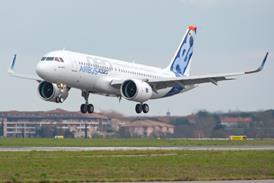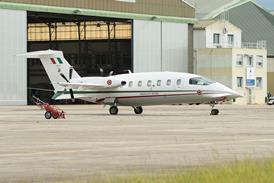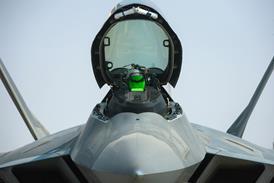If anyone needed to be reminded of the uncertainties and hazards facing new US airlines, they were outlined in full gory detail in the prospectus for the initial public offering (IPO) for JetBlue Airways.
There, the public learned that the many risks facing the two-year-old, low-fare carrier, included: a limited operating history; uncertainty about its ability to implement its growth strategy or renew or replace its gate leases; its dependence on the New York market; future increases in labour and maintenance costs, fuel prices, and insurance premiums; its fixed obligations; and potential industry, economic and regulatory changes, including increasing competition in its key markets.
These, however, did not stop hungry investors from substantially oversubscribing an already increased shares issue and driving up the stock price nearly 70% in the first day of trading. Indeed, within a month the company's $27 issue price more than doubled. The increase led one analyst to caution that the stock appeared overvalued and investors might want to reduce their holdings, but other analysts continue to rate it as a "buy".
The company netted $147.3 million with the sale of nearly 5.9 million new shares of common stock, at the same time converting the preferred shares held by the early investors into common voting stock. Original investors, including venture capital firms and individuals who provided $175 million in equity financing, now own about 71% of JetBlue. George Soros - through two companies he controls - is the largest shareholder with just over 23% of the company. The general public holds 16% of JetBlue's stock and company executive officers and directors as a group hold another 13%.
Certainly vital to the IPO's success was the track record of David Neeleman, JetBlue's chief executive, and the team he assembled to create and run the airline. But also critical were its impressive accomplishments since service began in February 2000.
The New York-based airline, which operates Airbus A320s to 19 cities - including a service to San Juan, Puerto Rico, that has just been launched - has flown more than 6 million passengers since start-up and has been profitable in each of the last five quarters. It earned $38.5 million last year, and even made money in the last three months, in which most US carriers were completely devastated. In the first quarter of this year, it again made money ($13 million) and reported an industry-best 17.5% margin.
While it is quick to point out that its first-quarter results benefited from Easter and Passover traffic, and that the second quarter's margin would not be as high, other carriers plainly would love to have such results.
The airline racked up an industry-leading 80.8% load factor in the first quarter, its best-ever despite the fact that the carrier more than doubled capacity at the same time. Average stage length rose 21% as JetBlue increased transcontinental flying, helping to lower unit costs by almost 10% to 4.2¢ per seat kilometre (6.8¢ per mile).
To the surprise of no one who knows him, 42-year old Neeleman is not going to rest on past accomplishments. "I think the way you best your competition is to never think you have," he says. "We're only as good as our last flight, and the minute we start believing our own press and think we've licked them - we've lost."
In an interview in Fort Lauderdale during the Airline Business Network 2002 conference where he gave a keynote speech, Neeleman ascribes JetBlue's success so far to a sound business plan, making the right decisions early on about aircraft and operating base, its highly-trained, dedicated and obviously happy employees, and its unequivocal focus on customers and determination to offer them "a fair fare".
JetBlue has cut through the customary fare maze, using a simplified low-fare pricing system which does not require a round-trip purchase or Saturday night stay. It does not overbook or use paper tickets, only e-tickets. And an ever growing percentage of passengers-55.1% in the first quarter-book flights on the company's web site.
Attractive fares
The airline's advance-purchase fares are usually 30-40% below existing business fare prices in the markets, while its "walk-up" fares are 60-70% below other carriers'. The fares attract business travellers, but Neeleman says the airline has no way of knowing how many without taking surveys. "But we really don't care," he says. "They all pay the same. We don't rip off business travellers like other people do. We treat everyone the same - well."
Starting with a lot of money also allowed JetBlue to invest significantly in its product, acquiring brand new - so reliable and efficient - Airbus A320 aircraft in a single-class configuration, with 162 leather seats and free satellite television. It has used advanced technology throughout its operations, becoming the first airline to introduce "paperless cockpit" flight technology and to install security cameras in the passenger cabin after 11 September.
The carrier provides no food on flights, only snacks and drinks, but is encouraging airport vendors, which it calls "business partners", to provide meals for passengers, especially as it increases its long-haul flying. It also has assigned seating in contrast to low-cost, low-fare model Southwest Airlines.
JetBlue has invested especially heavily in its employees, who numbered about 2,700 last month. "Our crew members are the product; they are the airline," Neeleman says. Their loyalty grew after 11 September when the airline did not delay aircraft deliveries, cut back service or lay off any staff, even those hired days before.
A case in point is the treatment of staff at Washington Dulles airport. In early September, JetBlue was starting to build up Washington to support its flights to California, due to begin in late October. Although it postponed service, JetBlue kept on the new hires, brought in computers and phone lines, and let them provide reservations support. JetBlue started service from Washington to Fort Lauderdale in late November, then Long Beach and Oakland last month.
The flexibility it has is often enjoyed by new carriers, avoiding the inefficiency-breeding work rules that often accompany unionisation. JetBlue officials intend to maintain this status. Last year, labour costs represented 28.9% of operating expenses, lower than at the majors, and it operated what Neeleman says is more available capacity per crew member than any other airline. "It's not because we pay people less," Neeleman says. "It's just because we're a lot more efficient."
Competitive wages
On pay, the carrier pegs wages for pilots - who become captains in 12 months - generally at Southwest's pay scale. Last autumn, without being asked, JetBlue raised pilot pay by 32% to make sure they were paying competitive rates, even though pilots have five-year work agreements.
JetBlue has outfitted its pilots in blue shirts, eschewing the military look at other airlines, as part of its brand-building, and to signal that it has a different approach. The airline is also attentive to the compensation needs of its non-flight deck employees.
JetBlue takes the view, Neeleman says, that it has a partnership with its crew members and they can only succeed together. Moreover, because "we always tell the truth", he adds, "they know they can trust us.
"If you have that, is there really a need to have a third party coming in and telling you how to run your business? We don't think so," he says. "We're committed to making sure that our folks don't think they need a third party to come in and take some money from them and make us less efficient and therefore hurt the whole company," he says, adding that such arrangements would only hurt employees who participate in its profit-sharing and stock-purchase plans. Those schemes explain in part why employees are smiling and embracing passengers. The company sets aside 15% of pre-tax earnings for profit-sharing; last year, payments equated to 13.5% of an employee's pay.
The new stock purchase plan allows all employees, part-time and full-time, to set aside 10% of their wages to acquire JetBlue stock at a 15% discount off the IPO price. For the next two years, the employee price for each share is $22.95. Two years from now, the price will be pegged at 85% of the market rate at that time. In addition, employees were given a one-time offer to purchase 200 shares of the company's stock at the IPO price, an offer half of them took up. "We wanted all the crew members to be shareholders so they could feel like it's their company, which it is," Neeleman says. "They all know when they give great service, profits increase and stock price goes up."
Employees are also encouraged to share their ideas for the airline and are involved in such tasks as naming JetBlue's aircraft. The "No Plain Jane Plane Name Contest" awards successful name-pickers and a guest with trips to Toulouse to take part in the aircraft delivery. Selected names, which must have "Blue" in them, have included Bada Bing Bada Blue, Born to be Blue, Rhapsody in Blue, Ol' Blue Eyes, Cool Blue and Estrella Azul (Blue Star).
The airline's fleet of 24 A320s is set to increase by another dozen by the end of the year. It expects to have 50 A320s in its fleet by the end of next year, and will take one new aircraft every five weeks for the foreseeable future.
Although JetBlue originally intended to add 10 destinations and 10 aircraft a year for the first three years, it has been expanding aircraft orders and scaling back its destination plans. It now expects San Juan to be the only city added this year, and it may add just one, possibly two, next year, Neeleman says.
"There is such demand for our product that it behoves us from a cost perspective to just add frequencies and tie the cities together," he says. "That's our number one preference because that way you can add flights less expensively, keep costs down and better utilise your existing crew members."
When JetBlue selects a new market, it undertakes an exacting process which weighs such factors as market size and elasticity and potential share, as well as airport costs and opportunity costs for the aircraft.
The process involves full profit-and-loss comparisons of new markets against adding capacity on existing routes. "We're really profit-motivated," says Neeleman. "There are some strategic things that enter in, but for the most part we just go where we can make the most amount of money."
From JetBlue's New York JFK base, it flies north to three upstate New York cities and Burlington, Vermont; south to five cities in Florida, New Orleans and now San Juan; and west to six cities: Seattle, Salt Lake City, Denver and three in California, including its West Coast base at Long Beach. It also serves three cities from Washington.
Unlike most airlines, JetBlue is also content to operate just one round trip into a city. It currently operates a single red-eye round trip to four western cities from New York - and has no expansion plans. "We're not in this for market share," Neeleman says. "We're in it to make a profit."
Financial goals
Although profit motivated, JetBlue officials told those asking about their financial goals during the IPO road show that they wanted "a margin of between 15% and 20%, but not more than 20%", says JetBlue president Dave Barger. "If it's higher than that, we're either gouging customers or not paying our staff enough."
JetBlue's major ambition for the rest of this year is to increase service from Long Beach. Last year, JetBlue was awarded all 27 remaining departure slots at the restricted airport and given two years to use them. This month, it will be using six slots, and was planning to phase in flights slowly through next May. Now, though, because American and Alaska Airlines are asking Long Beach for slots and threatening to sue, JetBlue has decided to accelerate its flight build-up to operate all 27 departures by October. It expects to operate nine more daily flights in August and the remaining dozen in October.
JetBlue expects to use the slots for flights to cities it already serves rather than new ones, Neeleman says. "We're going to do some connecting of the dots." Also in the pipeline for 2002 is the initiation of a fre- quent-flyer programme.
A loyalty scheme is considered especially important as JetBlue grows and faces increasing competition from major carriers. Because so many customers book electronically, JetBlue has been tracking them, and last year sent several hundred of its most frequent travellers a free ticket to thank them.
Neeleman says he doesn't worry about the competition, believing that there is enough business for everyone in JetBlue markets "at our fares". One of the potential names for the airline was "The Competition", Neeleman says. "So how are you flying to Florida? I'm going on the competition." As he says it, he clearly likes the way it sounds. "We should add that as our tag line," he says, "JetBlue, The Competition."
Although Neeleman emphasises the team nature of JetBlue's leadership, he is personally - "unfortunately", he says - linked to the airline and some have wondered how long he'll stay. "I can't think of anything else I'd want to do," he replies. "I've been through this before where you started something, you sold it, and you think: 'Hey, this is going to be it.' And all that was 'it' was that you were miserable after you created your baby."
Noting that he sold Open Skies to Hewlett Packard because he wanted tobe back in the airline business, he says he is staying put. Does he see himself in this job 10 years from now? "Sure." 20 years? "I don't know about 20, but certainly 10."
Source: Airline Business























